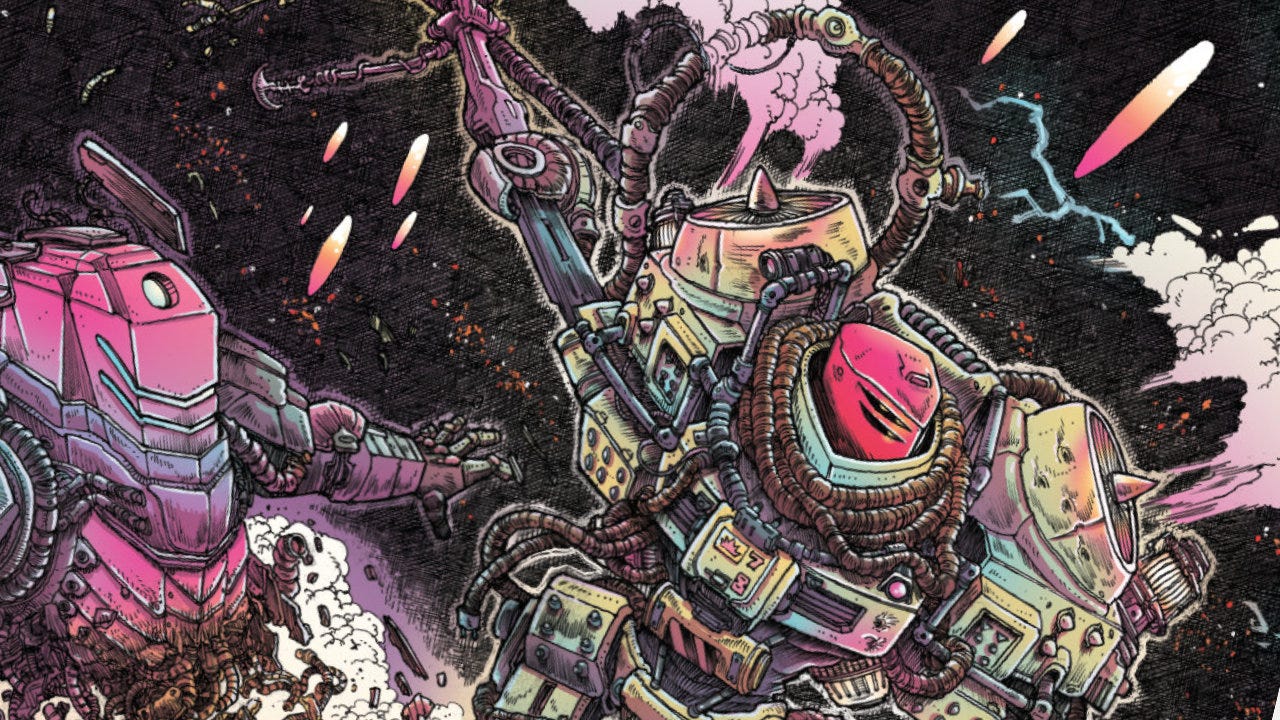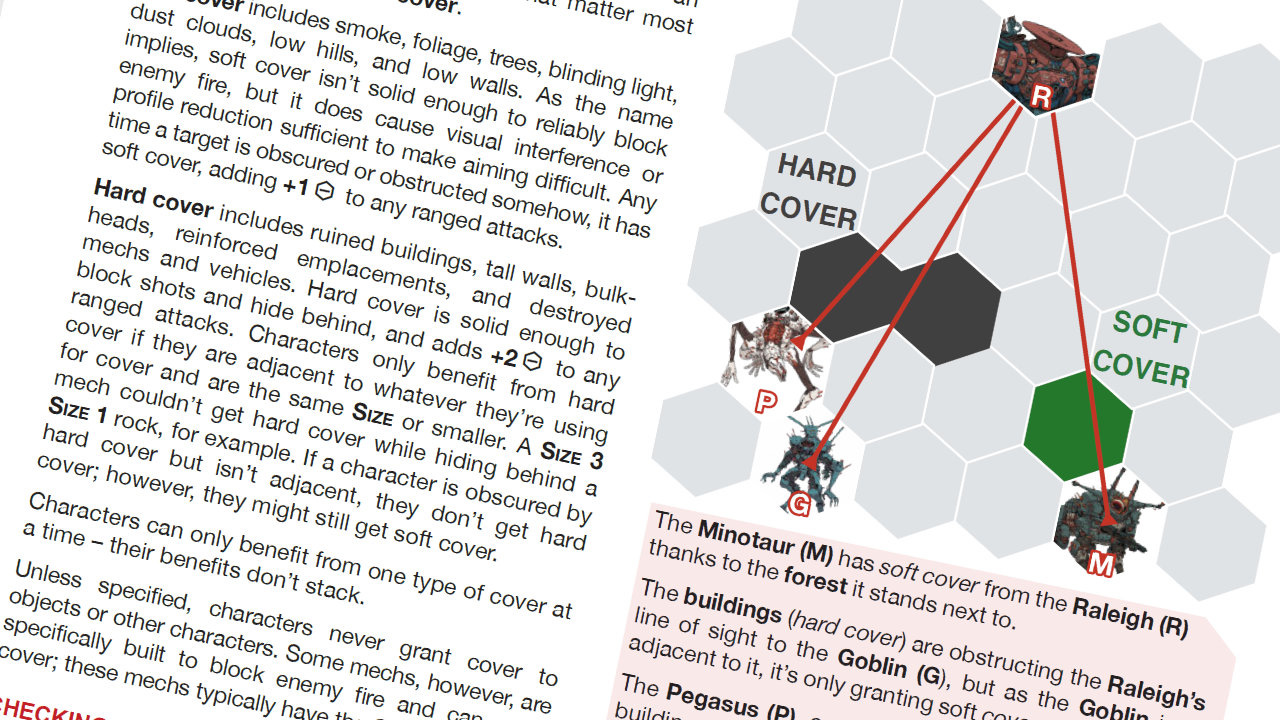MECH WEEK: Combat
Exploring range and attack patterns in Lancer (and Gloomhaven)
Welcome to Skeleton Code Machine, a weekly publication that explores tabletop game mechanisms. Spark your creativity as a game designer or enthusiast, and think differently about how games work. Check out Dungeon Dice and 8 Kinds of Fun to get started!
This is part of Skeleton Code Machine MECH WEEK — a week of articles (and coloring contest) about mechs in tabletop games: Part 1 - Is Iron Man a Mech?, Part 2 - Heat, Part 3 - Combat, Part 4 - Pilots, Part 5 - Systems.
There are countless ways to have combat in mech games. BattleTech uses d6 dice, a hex map, and (mostly) straight lines of sight. The mechs in Undaunted 2200: Callisto are activated using a deck-building card system and use d8, d10, or d12 dice depending on elevation relative to their target. Scythe uses a zero-luck simultaneous selection/reveal power system similar to a blind bidding system to resolve combat.
Lancer’s combat system is extensive, but let’s explore just one little part of it in detail.
Lancer
In 2019, Massif Press released the Lancer core rulebook. Where many future/sci-fi settings have a dark and dystopian setting, Lancer’s setting is the opposite — a far-future, post-scarcity utopia:
In practice, “post-scarcity” means that PCs on Core worlds will have access to most (unrestricted) consumer goods and not want for raw and necessary materials. Specialized items might require certain licenses that can be obtained through trade, clearance, or qualifications (i.e., as rewards from the GM), but even these are readily available once approval has been granted or secured. Any unrestricted items so ordered can be reliably obtained at the time they are requisitioned, or within a day or two at most.
The 430+ page book includes everything you’d need to know about this world and how to run a campaign in it. The mech combat in Lancer is tactical, crunchy, and feels interesting and unique. The turn-based system uses standard moves, quick actions (e.g. boost), full actions (e.g. barrage), reactions, overcharging (at the cost of heat), and a pile of other actions.
I could probably write an entire week’s worth of articles just on the Lancer combat system, but for today’s MECH WEEK article, I want to focus on just one thing: range and patterns in hex-based combat.1
Mech combat in Lancer
To be clear, Lancer isn’t just mech vs. mech fighting. The rules are careful to point out that, “It’s entirely possible to play through a session of Lancer without even touching a mech, let alone mech combat.” That said, mech combat can be a significant portion of (and attraction to) the game!
When combat begins, the game switches from narrative play to tactical and turn-based combat which takes place on a hex map. Your mech pilot still impacts the game (via “Grit”) but it is your mech’s weapons and abilities that will win or lose the battle.
Each combatant has a size ranging from 1 to 4, with a standard mech being size 1 and the heaviest “titanic mechs” being size 4. The size also represents how many hexes are occupied on the map by each mech.
There are three main types of attacks:
Melee: Weapon attack against a target within threat range and with line of sight.
Ranged: Weapon attack against a target within range with line of sight.
Tech: Tech attack against a target within sensors and with line of sight.
Attack rolls are generally 1d20 + Grit + (Accuracy/Difficulty) and try to match or beat the target’s Evasion. There is hard cover, soft cover, and line of sight that all impact the engagement.2
Most times, attacks are simply in a straight line and measured from any edge of the attacking character. Some weapons have, however, special attack patterns!
Range and patterns
Special ranged weapons may have any of the following four attack patterns (with descriptions from the Lancer rulebook p. 64):
Line X: Affects characters in a straight line, X spaces long.
Cone X: Affects characters within a cone, X spaces long and X spaces wide at its furthest point. The cone begins at one space wide.
Blast X: Affects characters within a radius of X spaces, drawn from a point within Range and line of sight. Line of sight is calculated from the center of the blast.
Burst X: Affects characters within a radius of X spaces, centered on and including the space occupied by the user (or target). If a Burst effect is ongoing, it moves with the character at the center.
While I really believe Lancer’s combat would be sufficiently interesting even if it didn’t have these special attacks, the addition of these types turn the combat into a fascinating tactical puzzle. Friendly fire becomes a concern. The fact that a burst can move with an opposing target is fascinating. Using a cone attack means that distance to target is really important.
I’m sure I’ve seen similar systems in other games, but one (albeit non-mech) immediately came to mind: Gloomhaven.
Area effects in Gloomhaven
Gloomhaven (Childres, 2017) uses an attack system with a similar hex-pattern mechanism:
Some attacks and other abilities allow figures to target multiple hexes or multiple targets at the same time. In these cases, the area of effect for the ability is shown on the ability card. Note that any rotational orientation of the depicted diagram is valid. Also note that each target constitutes a separate attack (drawing its own attack modifier card), but all attacks together make up a single attack action.
One interesting twist is that the patterns can be upgraded!
After completing a specific achievement, players can spend gold while visiting Gloomhaven (the town) to enhance their ability cards. As a legacy game, this is usually done by adding stickers to existing ability cards and permanently modifying them.
One type of enhancement modifies the area effect (hex pattern) on an attack card. An additional red hex sticker is applied to permanently expand the original attack area.
Classic legacy game stuff, but really interesting in how it changes future combat!
Position as important as attacks
I’ve played around with some skirmish game design in the last year or so, and one of my biggest challenges was making positioning matter. It was far too common for both players to just run directly at each other and just start pounding away — exchanging hits until one dropped.
One of my takeaways from the hex-based attack patterns in both Lancer and Gloomhaven is how they solve this potential problem: making positioning matter.
Even if you try to design faster combat systems, they can still become boring and repetitive if players are just taking shots at each other across the map. If the system doesn’t put pressure on the user, they may not bother moving. If position doesn’t matter at all, you don’t even need a map!3
The addition of not only hard/soft cover but special attack patterns means that positioning matters. The attacks can be strong, but you might have to pilot your mech out of cover to use them. There are times when you might be too close to friendly units to trigger the attack and need to back up. The cone attack in particular can require more distance to have maximum impact, causing you to move to get into the correct position.
It’s not the only way to make position matter in combat, but it is a good one.
Conclusion
Some things to think about:
Analyzing game mechanisms: With a core rulebook of over 430+ pages, learning everything in a game like Lancer can be a daunting task. As a game designer it is possible, however, to just dig into one tiny part of a game and still learn some valuable lessons. Don’t let big books frighten you away!
Make position matter: I spend a lot of time thinking about combat systems and how to make combat faster and more interesting. If the combat takes place on a map, consider how you can make position matter more. Think about how you can make movement part of the combat puzzle to be solved.
Line of sight: In Building Blocks of Tabletop Game Design, Geoff Engelstein calls line of sight (LOS) a “bedeviling aspect of game design.”4 I would agree. Once you add ranged attacks and patterns into combat, line of sight matters and it can quickly become complicated.
— E.P. 💀
P.S. If you enjoy Skeleton Code Machine, you’ll love TUMULUS — a new quarterly publication from Exeunt Press. Subscriptions are available right now!
Skeleton Code Machine is a production of Exeunt Press. All previous posts are in the Archive on the web. If you want to see what else is happening at Exeunt Press, check out the Exeunt Omnes newsletter.
Mech combat is covered on pages 58 - 84 (30+ pages) of the Lancer rulebook.
Both Lancer and BattleTech use hex-based maps and require line of sight (LOS) to targets. This can be complicated when playing on a flat map (vs. terrain models) and usually requires quite a bit of rules explanation. Unmatched’s colored zone system and Undaunted 2200: Callisto’s elevation dice are both interesting solutions to the LOS design challenge.
Many TTRPG systems have combat that does not require a map. While I love a good battlemap, I’ve played a few and really enjoyed them. This article is, however, about games with tactical combat that takes place on a map.









A useful way to think about combat, I believe, is to imagine it as a bidding war of certain assets.
Players can bid their assets to increase their chances to win the game, or to weaken/eliminate opponent's assets (in some games, eliminating opponent's assets IS the goal).
It would be trivial to make optimal bids if they would be done instantly, so combat games usually make the act of bidding a challenge in itself (you have to get units into positions, some positions make the bid stronger, some make it weaker). So, one of the component of bidding war is a system of committing the bids (and ranges & cover appear to be part of it).
The second component is what players bid on. If the combat system only has one place to bid on (like focusing the enemy caster), it's rarely interesting. If the system naturally leads to emergence of multiple bidding fronts, it usually provides much more decision space for the players.
Another matter is re-bidding. In many systems, once the bids are committed and the units engage their targets, the combat becomes very static, removing most of the decisions. So systems that allow to re-use bids again in some way (like disengaging to take better position or strike at a more vulnerable target), in my opinion, produce combats that can stay engaging while they unfold.